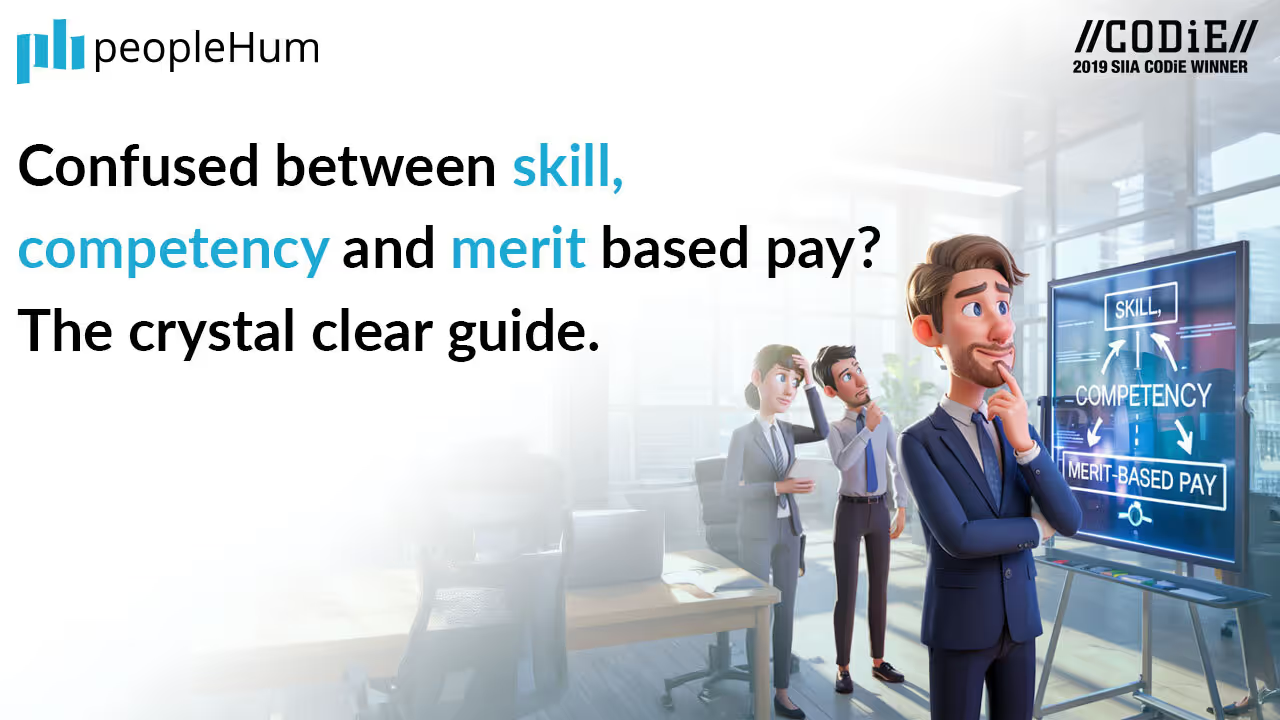You’re an HR manager staring at a spreadsheet that’s supposed to decide who gets paid what and the team’s yelling about "skills this" and "merit that," and you’re stuck wondering if you’re even speaking the same language. This world of pay structures is a messy jungle, and terms like skill, competency, and merit-based pay get thrown around like corporate buzzwords at a boardroom bingo game.
This is about giving CHROs, or managers, the tools to understand what these terms mean, why they matter, and how to use them without screwing it up. They throw around these terms, hoping something sticks, and their pay structure ends up looking confusing, mismatched and a mess. Stop the confusion and start building a system that actually works.
What’s the deal with skills, competency, and merit-based pay in an organisation?
Each one plays a different role in how you pay your people, and mixing them up is like putting ketchup on ice cream, disastrous and useless.
- Skill: This is the “can you do the job?” part. It’s about the specific abilities someone brings to the table, like coding in Python, designing killer presentations, or sweet-talking a client into signing a deal. Skills are measurable, teachable, and usually tied to a specific task, but just because someone’s got skills doesn’t mean they’re using them well.
- Competency: This is where it gets juicier. Competency is the how behind the skill. It’s the behaviors, attitudes, and smarts someone shows while getting the job done. Can they solve problems under pressure? Do they play nice with the team? Competencies are broader and harder to pin down, but they’re what separate the rockstars from the one-hit wonders.
- Merit-Based Pay: This is the “you get what you earn” philosophy. It’s about rewarding people for their overall performance, not just their skills or competencies. Think of it as the gold star for showing up, delivering results, and maybe even going above and beyond. Sounds simple, but it’s a minefield if you don’t know what you’re measuring.
So, why does this matter? Because picking the wrong approach can lead to unfair pay, grumpy employees, and a retention rate that looks like a horror movie.
Skills: Pay for knowledge, not labour
What if you paid your employees not for what their job title is, but for what they know? That’s the core idea of skill-based pay. It’s a compensation model that says, "We'll pay you more because you learned a new, valuable thing."But, just because someone’s got a shiny skill doesn’t mean they’re worth a fat paycheck.
The focus here is entirely on capability. Their output hasn't changed, they haven't finished a new project, and they aren't leading a team. But their value to the company has just gone up exponentially. Under a skill-based pay model, you'd give them a raise specifically for acquiring that new skill. It's a direct reward for growth and learning.
This model is all about building a flexible, versatile, and highly capable workforce. You're not just hiring for a job; you're investing in a person's potential. . Employees seek training, learn new technologies, and expand their knowledge base. This creates a workforce that's constantly evolving and staying relevant in a fast-paced market. .
Competencies are more than just buzzwords
Skills get you in the door, but competencies keep you there. These are the traits that make someone a star: problem-solving, teamwork, adaptability, or leadership. Competencies are why one employee can take the same skills as another and absolutely crush it.
How to nail competency-based pay without playing favorites
- Define what matters: Not every competency is created equal. For a company, maybe it’s creativity or customer focus. For another, it might be grit or strategic thinking. Work with your leadership to pinpoint the top competencies that drive your success.
- Use real examples:Spell out words, with proper clarity, don’t just say “we value teamwork.”Teamwork means collaborating on projects, mentoring newbies, and not throwing your coworker under the bus in meetings. Be specific so everyone’s on the same page.
- Get feedback from everywhere: Use 360-degree feedback to see how employees show up across the board, peers, subordinates, clients, you name it, if you’re only asking the boss how someone’s doing half the story is already missing
- Reward the right behaviors: Reward the folks who pivot like pros, not the ones who stick to the script and hope for the best. Tie pay to competencies that actually make a difference.
What is merit-based pay, and why is it such a hot mess?
Merit-based a merit pay incentive system is based on individual performance, and rewarding for doing a great job. It’s a walk between fairness and chaos, it's tying compensation to overall performance, skills, competencies, results. Though it can also spark jealousy, confusion, and straight-up rebellion if you don’t get it right, but when it’s done well, it’s a powerful way to keep your best people happy and motivated,
Merit-based pay backfires if it’s too subjective and not consistent. If one team gets bigger bonuses than another for no clear reason, you’re asking for trouble. Keep it fair, and you’ll keep the peace.
- It's about “what you did”: Rewards past performance and achievements. It's tied to key performance indicators (KPIs), sales numbers, project completion rates, or other objective measures of success. It's a way to directly incentivize and reward the top performers in your organization.
- Clarity of purpose: For employees, the goal is clear: hit your numbers, and you'll get a bigger bonus or a better raise. It creates a direct link between an employee's efforts and their financial reward.
How to make merit-based pay work without starting a riot
Merit pay isn’t handing out gold stars like candy, it is when the right people are rewarded for the right reasons. Here’s how you can make a way:
- Set clear goals: Use SMART goals (specific, measurable, achievable, relevant, time-bound) to give everyone a clear target. The employees should have clarity, if they don’t know what “good performance” looks like, they’re just guessing.
- Be transparent: Explain how merit pay is calculated, who’s involved, and what criteria you’re using.Nothing kills trust faster than secret pay decisions.
- Check the biases: Humans are messy, and so are their judgments. Make sure your merit decisions aren’t swayed by who’s loudest in meetings or who brings you coffee. Use data and feedback to keep it objective.
Mixing it up: A hybrid Approach
Most companies don’t pick one of any, and call it a day. They blend each of it where needed, maybe pay a base salary for skills, add bonuses for competencies, and top it off with merit-based raises for performance. The key is they balance it all.
If you lean too hard on skills, you’ll end up with a team of solo artists who can’t collaborate. Focus only on merit, and you might overlook the quiet contributors Experiment, and keep talking to your team to find what works.
Skill vs. Competency vs. Merit
Should your pay be based on skills, competencies, or merit? But, it’s not an either-or deal. The best pay structures blend all three, but the mix depends on your company’s goals, culture, and industry.
Why getting this wrong can screw you
Let’s not sugarcoat it: A bad pay structure is a one-way ticket to a toxic workplace. Here’s what happens when you mess it up:
- Talent drain: If your best people feel underpaid or unfairly treated, they’ll bolt.
- Low morale: Nothing kills team spirit faster than a coworker getting paid more for less work. Resentment spreads like wildfire.
- Legal headaches: If pay decisions seem discriminatory or arbitrary, you’re begging for a lawsuit. Equal pay laws aren’t messing around.
- Wasted budget: Overpaying for skills that don’t deliver or rewarding the wrong behaviors is like flushing money down the toilet.
Wrapping it up: Pay smart, win big
These are tools to build a team that’s happy, productive, and sticking around for the long haul. Get clear on what each one means, use strategically, and don’t be afraid to mix and match.The goal isn’t to have the perfect system. It’s to have a system that’s fair, transparent, and gets your people excited to show up.
This means you might use skill-based pay to reward employees for getting new certifications in a critical area, use competency-based pay to determine promotions and leadership opportunities. And use merit-based pay to provide an annual bonus for hitting team-wide or company-wide goals.
So, next time you’re staring at that spreadsheet, wondering who deserves what,know to pay for the skills that matter, reward the behaviors that shine, and give merit where it’s due..


















































